The mushroom of the nails of the legs or the icydomicosis is a common problem with which each person risks facing life, regardless of age or social status.This disease is accompanied by extremely unpleasant symptoms associated with aesthetic changes in the nails and in physiological discomfort.
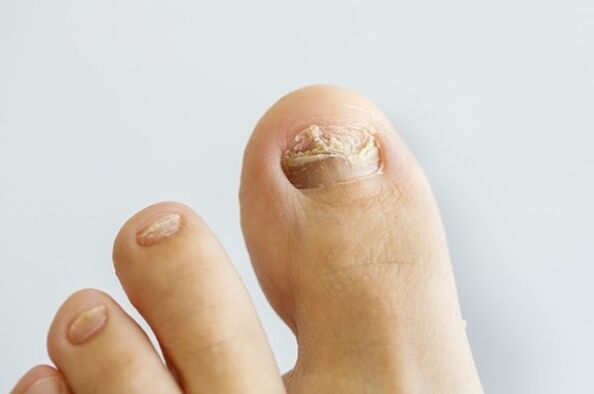
Causes of damage to the fungal nails
The damage fungus to the legs on the legs in medical practice is much more common than a similar disease on the hands.This is due to the fact that the lower limbs are much more often in contact with the contaminated environment.In this case, the main cause of the occurrence is a reduction in immunity.The weakened body is unable to completely resist an infectious agent.
If we speak in particular of the mushroom on the nails of the legs, there are a series of factors that contribute to the infection:
- Visiting public places without shoes.This is particularly true for bathrooms, saunas and swimming pools, showers in gyms or production, hospital departments in the hospital.In the first two cases, the risk of infection is elevated due to the participation of these places by people who are vectors of fungal infection.In addition, mushrooms multiply more actively in a wet environment.Despite the respect of health standards, hospitals are a place of concentration of various infections, including the fungist ones.Having become barefoot on the floor in one of these places, the probability of obtaining an infection grows ten times.
- In the absence of regular cleaning with aggressive chemistry, its bathroom also becomes a plants of fungal infection.Although none of the domestic ones was sick with onychomycosis, conditioned pathogenic mushrooms that live on human skin multiply in the unslameful bathroom.An increase in their population leads to deplorable consequences.
- Wearing old shoes or other people, even the conditioned pathogenic mushrooms are on the skin, their shoes that enter (especially the closed type) are inevitable.Microorganisms accumulate in the layers of fabric, which also increases the risk of infection.
- Wearing shoes is not seasoned: one of the infection factors is the excessive sweating of the legs.If a person walks with shoes closed in summer or wears hot shoes in the room, the probability of fungal damage increases.However, a periodic cutting of nails and a negligent washing of the soap legs may not be sufficient.It is important to cut the nails regularly, cut the coffins and push the cuticles, use special lotions and constantly clean the keratinized layers of the skin.
- Injuries - we are talking about damage to the nail plate on the fingers with blows, bruises, cuts.In such cases, blood circulation is disturbed in the damaged area, the nail does not receive the correct amount of nutrients.This can cause the development of the mushroom.
- Types of mushrooms and characteristics of damage to the nails on the legs
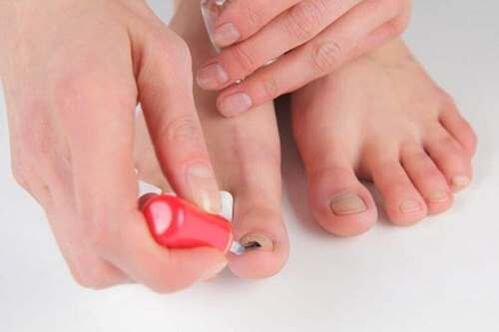
The characteristics of the treatment depend on the identification of the mushroom species that affect the nail plate.This is due to the possibility of selecting drugs that show activities in relation to a particular type of pathogen and the implementation of the most effective treatment.
Dermatophytes
The most common type of pathogen.According to statistics, dermatophytes cause a mushroom on the nails of about 75-80% of cases.In this case it is that the state of the immune system occupies the main role in the occurrence of onychomycosis.With normal immunity, dermatophytes fungal damage is almost impossible.
The infection comes from people or animals who are carriers, as well as in contact with the soil.Cemelocytes, the cellular structures of the epidermis, whose high content are observed in the nails are a means of favorite nutrition of this type of mushroom.
L'infezione proviene da persone o animali che sono portatori, nonché a contatto con il suolo. I ceratinociti, le strutture cellulari dell'epidermide, le cui elevate contenuti sono osservate nelle unghie sono un mezzo di nutrizione preferito di questo tipo di funghi.
Two main subspecies are distinguished in the caste of dermatophytes, the pathogens of Aschomycosi:
- Trichophophyte Rosso (Rubrum) - The beginning of the pathological process occurs at the end (external or free) of the part of the nail, from where the infection gradually moves to the root of the nail plate.In most cases, it is this subspecies that affects the fingers of the feet.It is characterized by simultaneous damage to the nails on more fingers (often standing near).The characteristic signs of infection are the thickening of the affected area of the nail and its delamination.The skin under the external facet of the nail plate dries and peels.
- Trichophyton is integrated - in this case the onychomycosis of the white surface develops.The favorite habitat of the subspecies is wet, it is often found in bathrooms, bathrooms, swimming pools.The causal agent affects the thumbs of the lower ends more often, after which "captures" other nails.A feature feature is considered a focal damage to the nail plate with the appearance of separate white spots or stripes.In the future, the white areas grow, combining together.When the fungal life forms spread to other fingers, there are areas of dried leather and peeling between the fingers.
Lievo
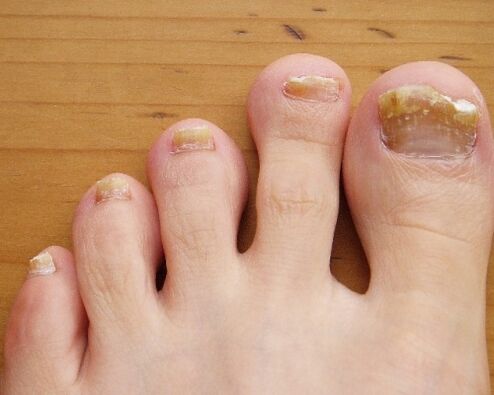
Another pathogen of gun damage to the legs on the legs are the conditioned pathogenic mushrooms of the Candida family.They are considered conventionally and pathogens due to the fact that they constantly live on the surface of human skin.That is, for infection, contact with an infected person, an animal or an external environment does not need at all.In this case, the main trigger of the pathology is a significant reduction in immunity, immunodeficiency.
Unlike dermatophytes, yeast mushrooms do not form a layer of mycelium, that is, the destruction of the nail plate with this form of damage occurs much less often.But the same factor makes the infectious lesion heavier, since the beginning of the pathological process takes on the (proximal) root side of the nail.These varieties of mycosis are considered more serious, but at the same time rare.
The first characteristic characteristic of the pathological process caused by yeast mushrooms is the detachment of the upper layer of the nail plate.For this reason, the nail loses its shine, becomes boring and rough.The damage to nails with yeast mushrooms occurs in about 7-10% of cases.
Tabs
The most insidious type of mushrooms, since these forms of life are almost everywhere (but above all in a humid environment).The gun damage to the nail on the leg can cause about 35-40 subspecies of molds.
Despite the prevalence in the environment, this form of onychomycosis is rarely diagnosed.In part, therefore, as well as due to an atypical clinical picture, mold is more difficult to diagnose and treat.Another reason for the complexity of the diagnosis of onicomicosis of the mold is the ability of the mushroom mushrooms to form the mycelium, which makes the clinical image a design with damage to dermatophytes.
The fungal life forms mainly affect the nails on the legs and the infection with subspecies is about 10-15%.In the initial stages, the mushroom can remain unnoticed.But there are still symptoms of the early stages of the development of the pathology, which are important to pay attention to:
La maggior parte dei tipi di danni fungini alle piastre di unghie avanza lentamente. Nelle fasi iniziali, il fungo può rimanere inosservato. Ma ci sono ancora sintomi delle prime fasi dello sviluppo della patologia, che sono importanti a cui prestare attenzione a:
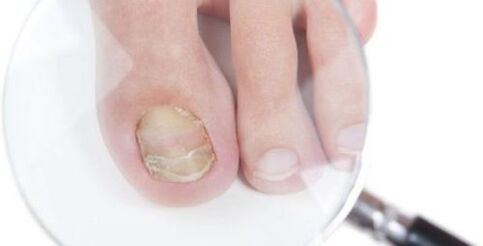
- The violation of growth is the first and most flashy sign.In a state, the nail on the leg grows no more than 2 mm per week.The nail plate, hit by the mushroom, slows down the growth rate.
- By changing the color - first of all, the nails affected by the mushroom dissolve, losing the shine, becoming opaque.It also notes that the appearance of white or yellow interspersed on the surface of the nail or a complete change in the color of the nail plate (white, yellow or shades of brown are possible).Changing the color from the nail mushroom in the photo above.
- The formation of coffin and damage to the cuticle is another indirect attribute that indicates the injury of the nearby skin mushroom.If the Burrs have started to appear more often and the area of the cuticle is systematically inflamed or damaged, it is worth checking the presence of a fungal lesion.
- Inspetement or thinning of the nail plate - the variations depend on the damage to the specific types of mushrooms.
As the pathological process advances, the symptoms are becoming more evident, it is more difficult to ignore it.The clinical signs of the subsequent stages of the icydomicosis include:
- Change the surface of the nail plate: it becomes rough and irregular, dotted with tubercles and waves.Even on the nail, similarities of the crumbs may appear, which indicates a gradual detachment of the upper layer of the nail.
- In the still later phases, the nail gradually begins to collapse.Initially, this is expressed in the stratification of the nail plate, the appearance of cracks on the entire surface or chips on the outer edge.This is the appearance of this feature of the mushroom on the nails of the legs in the photo.
- In the future, the destruction is even more serious.The nail literally crumble, not having time to grow.At the same time, the sub -gear sections of the dermis are exposed and the remaining parts of the nail seem clearly painful and not very attractive.As a result, there is the risk of complete destruction or detachment of the nail plate.Serious injury with a nail fungus in the photo above.
The danger of complications
Many unpleasant sensations and the deterioration of the appearance of the nails of the legs are only the upper part of the iceberg.The lack of timely treatment threatens the development of complications, among which the most common are considered:
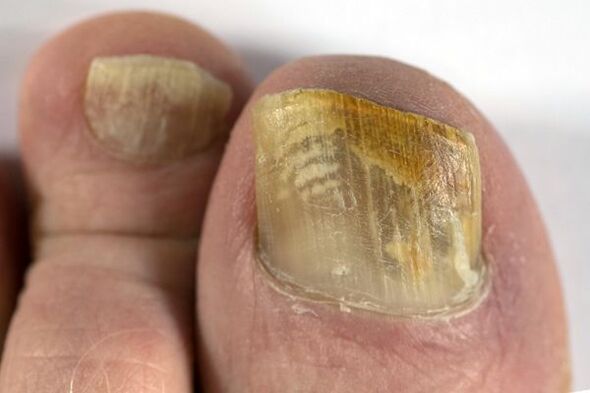
- Allergic reactions - in some development phases, the mushroom of the legs can be perceived by the body as allergen.
- The fungal damage can weaken the body's immune system, cause the development or progression of a series of diseases, including systemic ones.Other infections in the affected areas.Consequently, inflammatory and purulent processes develop.
- Particularly serious cases, without prejudice to a prolonged course and a progression of the disease, can lead to the development of fungal mycosis.In this case, the fungal life forms can penetrate the blood and will be spaced throughout the body.
- Methods of treatment
For the maximum effectiveness of the treatment of nail mushrooms on the legs, complex therapy is often used.At the same time, it is previously important to conduct diagnostics by sowing on a bacterial environment in order to determine the type of pathogen and choose the most effective drugs.An integrated approach provides for the combination of different types of therapy, but sometimes this is not enough.
Medicines
drug therapy is the basis for the treatment of most pathologies, including fungal nails lesions.As part of the treatment, two main groups of drugs are used, depending on the stage of the development of the pathological process:
- Local action type - these include ointments, gels, paints, creams, sprays and lotions with antifungal activities.The method, multiplicity and duration of the use of these drugs are determined by a doctor, but in most cases at least 2-3 weeks are used.For the most part, these are compressed that, after having suck the gastrointestinal tract, penetrate the blood and inhibit the forms of fungal life and do not allow mycosis to spread.The use of systems is important not only to improve the therapeutic effect, but also in order to prevent recurrence.
- Popular remedies
Traditional medicine is considered an auxiliary method to combat the mushroom on the legs.Popular recipes can improve the antifungal effect.The most effective are considered:
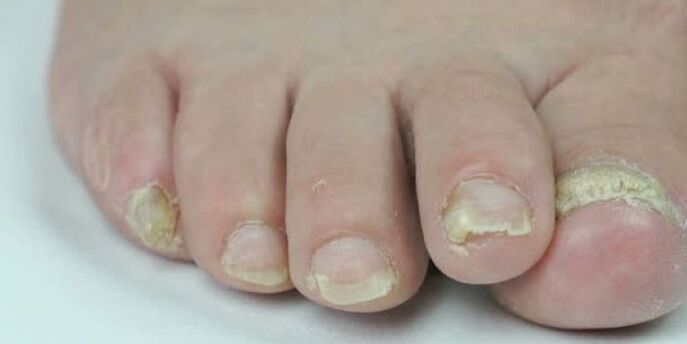
iodine: it is able to dissolve protein structures, which are the basis of fungal life forms.For the treatment every day, it applies a few drops of iodine to the areas concerned with a cotton pad.
- Peroxide is an effective antibacterial agent that has a disinfectant effect.To improve the effect, peroxide is mixed in equal proportions with vinegar.So the patient is lubricated with a mixture, it is not necessary to rinse it.The procedure is repeated every day for 1-2 weeks.
- Ceilandine - The best method for the use of this plant for the treatment of the mushroom on the nails of the legs are the balls.To do this, take a spoonful of crushed raw materials (leaves and twigs), pour 0.5 liters of water and bring to a boil.The decoction is defended within 15-20 minutes, after which the legs are immersed in it for another 20-25 minutes.Repeat the procedure every day before bedtime for 2-3 weeks.
Riming of the nail
Today in medical practice, mainly the chemical method to remove the nail plate - the windings are used.For this, special aggressive drugs are used, the procedure is performed by a doctor in order not to damage healthy areas of the plate and the skin.This method is painless and effective and the indications for its use are the absence of the results of the conservative treatment or the advanced cases of onychomicosis.
Laser therapy
The procedure provides for a partial or complete removal of the nail plate.The choice of the method depends on how deeply the mushroom penetrates the nail structure.During laser therapy, an intensive method of laser irradiation is used.A special apparatus is removed with a layer of nail mushrooms, after which follows an antifungal therapy path.

The complete removal of the nail plate with a laser is necessary if the nail is completely influenced by the mushroom, at the base.In this case, after removal, a bandage is applied to the naked areas of the skin, according to which it is possible to present an ointment or a cream with an antifungal effect.The removal of the nail plate requires regular visits to the doctor to perform medications and monitor the growth of the new nail plate.
The laser treatment of the nail fungus on the legs, during which only a few layers of the nails are removed, are performed in phases, within 7-10 procedures (about 10-15 minutes are needed to process each nail).If the removal is shown, the procedure disappears and lasts about 20 minutes, the patient does not feel pain.


















